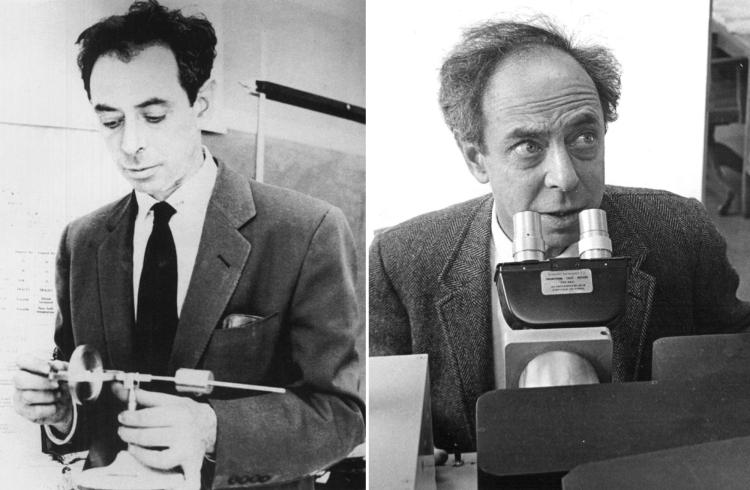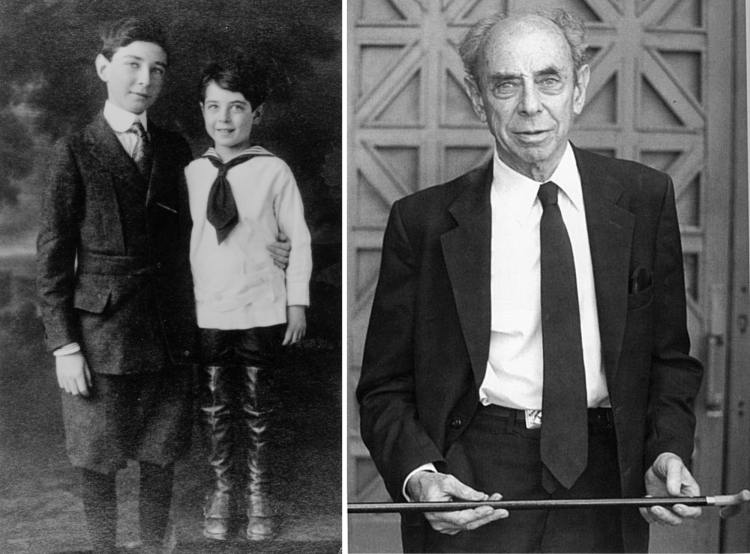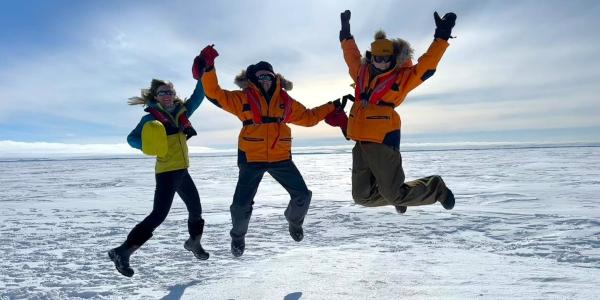In a little-known chapter of university history, the Manhattan Project scientist taught for several years in the Department of Physics, and his legacy appears in the fabric of the department
Al Bartlett, the legendary University of Colorado Boulder physics professor, was a judge for the combined Colorado-Wyoming high school science fair in the mid-1950s. One year at the awards banquet, he later recalled to author K.C. Cole, many of the winners suddenly were from Pagosa Springs High School.
Pagosa Springs? Where even was that? As each Pagosa winner was announced, the faces of students from bigger, more prestigious Denver high schools fell further, Bartlett recalled. Many of the Pagosa students were Hispanic, many from “ordinary origins” and many bussed to the competition by their science teacher.
As for that teacher, Bartlett would later learn it was someone with whom he shared a background—working on the Manhattan Project developing the atomic bomb. And someone who, within several years, would become his colleague in the CU Boulder Department of Physics.
Paul Beale, a CU Boulder professor of physics, remembers Bartlett describing how he asked someone about this new science teacher and was informed the gentleman’s name was “Oppen-something.”

Frank Oppenheimer (left) was played by Dylan Arnold (right) in Christopher Nolan's Oscar-nominated film Oppenheimer. (Frank Oppenheimer photo: Bettman Archive; Dylan Arnold photo: Universal Pictures)
Ahhh. Well, OK then, that explained it. Oppenheimer. Frank Oppenheimer, younger brother of J. Robert Oppenheimer, brilliant particle physicist, Manhattan Project scientist, blacklisted as a communist and, in a history not widely known, onetime CU Boulder faculty member.
Since the summer 2023 release of Christopher Nolan’s film Oppenheimer, which on Tuesday earned 13 Academy Award nominations, the surname has become popularly synonymous with science. While Robert may be the more famous brother—and the film’s subject, due to directing the Los Alamos Laboratory when the Manhattan Project was housed there—Frank’s scientific legacy runs similarly deep.
In the several years he taught physics at CU Boulder, Frank Oppenheimer not only made science exciting and accessible, but he initiated the creation of the Library of Experiments. This library allowed instructors greater freedom in tailoring physics instruction, getting away from the “do these steps and this should happen” approach, and allowing students hands-on learning.
There were no “black boxes, no gimmicks, no contrivances to make an experiment work in accordance with theory,” recalls Jerry Leigh, who was hired at CU Boulder to work with Oppenheimer on the Library of Experiments. “Students could apply textbook principles to an apparatus directly, and ‘see’ the principles contained therein.”
It was an exciting way to learn science, Leigh says, and Oppenheimer was excited about science.
A winding path
By the time Oppenheimer arrived at CU Boulder in 1959, he had already helped develop the bomb that ended World War II, been branded a communist, sold a Van Gogh painting to buy a ranch and guided a high school of fewer than 300 students to state science fair glory. Among other things, of course.
Following the war and his work on the Manhattan Project, Oppenheimer accepted a position teaching physics at the University of Minnesota. However, he was “outed” as a communist in a 1947 Washington Times-Herald article and eventually called before the House Un-American Activities Committee (HUAC) in 1949.
He initially denied any communist affiliation, but eventually testified that he and his wife, Jackie, had been members of the American Communist Party for about three years in the late 1930s, when they lived in California and were active in efforts to desegregate a public swimming pool in Pasadena.
As a result of his HUAC testimony, Oppenheimer was pressured to resign his position at the University of Minnesota, was denied his passport and could not get a job anywhere working in physics. He was understandably angry, and noted in a letter to his friend, esteemed physicist Robert Wilson, “At the moment it seems that all organizations that men create are either impotent or monsters."
However, admitting that he “acted badly” by not better explaining himself to the HUAC, Oppenheimer further wrote, “I think if one does not try to explain what one believes in and still pretends to be an intellectual, then soon one ceases to believe in anything."

Frank Oppenheimer demonstrates a gyroscope at Pagosa Springs High School (left) and uses a microscope in 1967. (Left photo: Stanely Fowler, Oppenheimer's former student; right photo: Bill Johnson/The Denver Post)
Oppenheimer’s father had been a passionate art collector and from him Oppenheimer inherited, among other works, the Van Gogh that he sold to buy a 1,500-acre ranch near Pagosa Springs in southern Colorado. Frank and Jackie, and their son and daughter, ranched cattle for about 10 years, becoming good neighbors and active in the community, Cole wrote in her book Something Incredibly Wonderful Happens: Frank Oppenheimer and His Astonishing Exploratorium.
When a teaching position opened at Pagosa Springs High School, Oppenheimer, who earned a PhD in physics from Caltech, seemed right for it but didn’t have state teaching credentials. The community, Cole wrote, was appalled that the state wouldn’t give him a license to teach, so he was granted temporary licensure while taking correspondence courses in education.
He wrote in a research paper for his credentials, “I am certain that mathematicians must frequently run into some object that they want to play with or investigate much as one is always tempted to play with magnets or gyroscopes or Silly Putty.” It foreshadowed his later work to help evolve science education so that it was fun, hands-on and playful.
Excited about teaching
Oppenheimer earned his full teaching credential in 1957 and at that point was teaching physics, chemistry, biology and general science in a community of about 850 people that hadn’t previously had a dedicated science teacher. Not long thereafter, Oppenheimer’s students began arriving at the University of Colorado and wowing their professors, physicist Hal Zirin told Cole.
In summer 1958, Oppenheimer and his family moved to Boulder in part so he could position himself for opportunities at CU. He helped develop a new National Science Foundation curriculum and taught in the Summer Institute for High School Physics Teachers. He also taught special physics classes throughout Jefferson County.
During this time, Cole wrote, Oppenheimer “realized that the teachers themselves had to be excited about the material and engaged in discovery or they'd never be able to inspire, or even adequately teach, their students.”
After returning to Pagosa Springs so his son could complete his sophomore year of high school, Oppenheimer’s strategy of positioning himself for entry into CU faculty paid off, and in 1959 he was offered a position as a research associate. His past in the American Communist Party continued haunting him, though, and several members of the Board of Regents attempted to block his appointment.
Fortunately, Wesley Brittin, who was then chair of the CU Boulder Department of Physics, was strongly on Oppenheimer’s side, showing tremendous courage in the face of intimidating opposition, Beale says. Brittin sought letters of recommendation from such esteemed physicists as Hans Bethe, George Gamow and Victor Weisskopf. During the Board of Regents meeting to determine Oppenheimer’s fate at CU, Bartlett and several of his physics colleagues waited anxiously outside the door, Bartlett recalled to Cole.
Oppenheimer became an associate professor in 1961 and a full professor in 1964.
While at CU Boulder, Frank Oppenheimer created a video series explaining the various experiments in the Library of Experiments. See the entire series here.
Building a Library of Experiments
Oppenheimer was already established in the physics faculty when Allan Franklin, now a professor emeritus, joined the faculty as a young scientist. Though he could easily have been in awe of the famous—some might say infamous—physicist, Franklin recalls Oppenheimer as kind and generous to an early career scientist.
“He invited us to his home on High Street in downtown Boulder,” Franklin remembers. “He was quite a modest guy, and I never remember him being bitter about how badly he’d been treated.”
Franklin recalls a friend telling him about complimenting Oppenheimer on the collection of art hanging on his living room walls, noting to Oppenheimer that a particular painting was “’the best copy of Picasso I’ve ever seen.’ And Frank says, ‘It’s not a copy.’”
Oppenheimer also never expressed a sense that he existed in his famous brother’s shadow, Franklin says: “J.R. was a theorist but Frank was experimental. He was really interested in teaching, and he completely revised our sophomore modern physics labs.”
Those revisions would evolve into the Library of Experiments, which created a “cafeteria” approach to physics experiments. Rather than every student in class doing the same experiments, a student could choose the required number of experiments that interested them the most.
Leigh recalls that Oppenheimer had clear ideas about what he wanted an experiment to be. “I was to assist teaching assistants with growing classes, devising and fabricating fixes for (Oppenheimer’s) often crudely built apparatus and repair lab documentation written hastily without editing,” Leigh says.
—David Hays, University Libraries archivist
“At first, Frank was somewhat distant, but friendly. Students were grouped at each experiment in twos or threes, so Frank circulated among the groups and politely offered suggestions and asked challenging questions of students, yet never intruding or confronting them.
“Over time, Frank began to approach me saying, ‘There is something want to show you.’ He would demonstrate some apparatus, pointing out items in need of improvement. The first involved a Polaroid camera that was mounted on a heavy stand that was tilted to provide data. The motion being studied was sinusoidal, and tilting the camera abruptly changed the field of view so the data was often bad. So, I had a shop make a mount that changed the camera’s position sinusoidally. Data became perfect and Frank beamed with joy.”
In another experiment, a steel ball was held up by an electromagnet and then dropped, providing a measurement of Earth's gravitation. The ball often stuck to the magnet instead of falling, so Leigh glued a small fiber washer to the magnet and fixed the problem, “and Frank glowed with satisfaction,” Leigh says.
Oppenheimer envisioned experiments for radioactive decay, the Doppler effect and Millikan oil drops, among many other elements of physics, and received national acclaim for the Library of Experiments while he was at CU.
"His 'library' of sophisticated science toys operated in typical Frank style—which is to say with a large measure of anarchy," Cole wrote. "He insisted on not having a lab manual, for instance, because he thought it would be too confining and inhibit free exploration. He liked to work with students one on one, encouraging them to ask questions and always making suggestions: 'Why don't you try this?'"
Having a lab with Oppenheimer was an incomparable educational experience, even for a professional, Bartlett told Cole. "He was personally setting an example of how fascinating it was to be engrossed in the excitement of learning physics. His enthusiasm was contagious. He seemed to take so much pleasure getting other people to see the interesting things in what he was doing."
In retrospect, it’s easy to see that Oppenheimer was testing ideas for what would become the Exploratorium, a hands-on public learning laboratory for all ages in San Francisco, California. Prior to founding it in 1969, Oppenheimer was awarded the first of two Guggenheim Fellowships in 1965 to study the history of physics and research bubble chambers at University College London. (The University of Colorado granted Oppenheimer a series of leaves until he became professor emeritus in 1979.)

Left photo: Frank Oppenheimer (right) with his older brother, J. Robert Oppenheimer. Right photo: Frank Oppenheimer in his later years in San Francisco; he died in 1985. (Left photo: AIP Emilio Segrè Visual Archives; right photo: K.C. Cole/courtesy Houghton Mifflin)
A legacy of learning
Oppenheimer built the Exploratorium into a nationally and internationally recognized center for public science, never losing his curiosity or enthusiasm for science, Franklin says. He recalls visiting Oppenheimer and his wife in San Francisco around 1970.
“They had a house near the top of Lombard Street, and when I was staying with them I remember seeing an ad in the paper that Jefferson Airplane were going to be playing at the Fillmore West,” Franklin says. “I asked Frank if he wanted to go and he said yes, which shouldn’t have been surprising because he was always curious and open to new things. We were older than the rest of the audience, and people were looking at us like we were narcs. But they played a 30-minute version of ‘White Rabbit’ at that show, and I remember Frank was really into it.”
Despite Oppenheimer’s relatively short time at CU, his legacy is woven into the fabric of the Department of Physics. “Teaching and learning have been central for this department forever," Beale says. "Like when Frank was here, we have students doing hands-on, real science—publishable stuff when they’re even freshmen and sophomores. One example from the COVID era was something students could work on online, using this huge dataset available from NASA that had not been combed through at a level it needed to be. So, students were doing that real-world data analysis and then having a published paper in an astrophysical journal about solar flares at the end of it.
“I tell students when I first meet them coming out of high school that science is a human endeavor; there has to be room for trial and error. If you do an experiment and get what you expect every time, you haven’t really learned anything or done science. I think that’s why we wanted Frank here in the first place, because he strongly believed that, too.”
Did you enjoy this article? Subcribe to our newsletter. Passionate about physics? Show your support.



